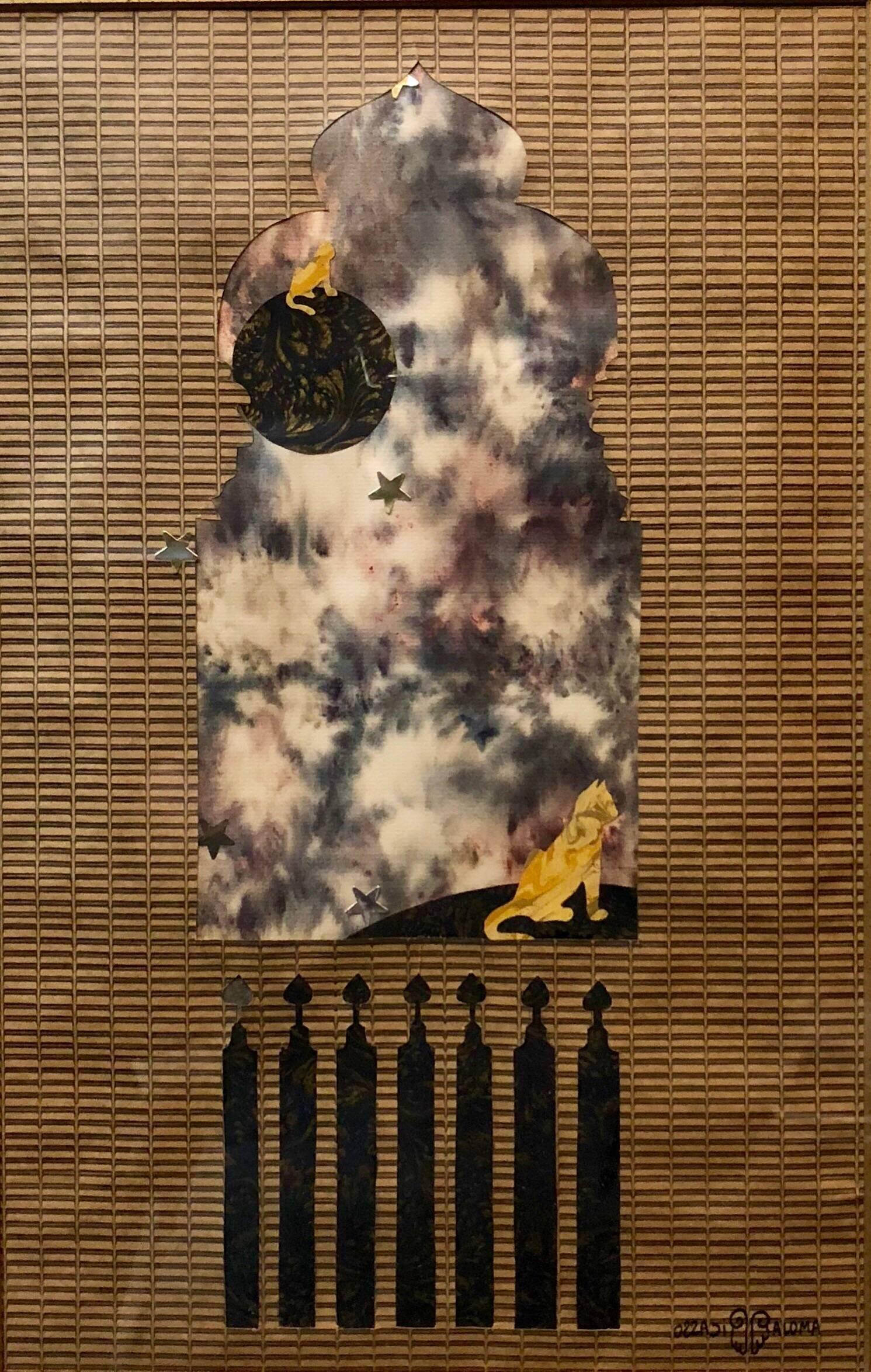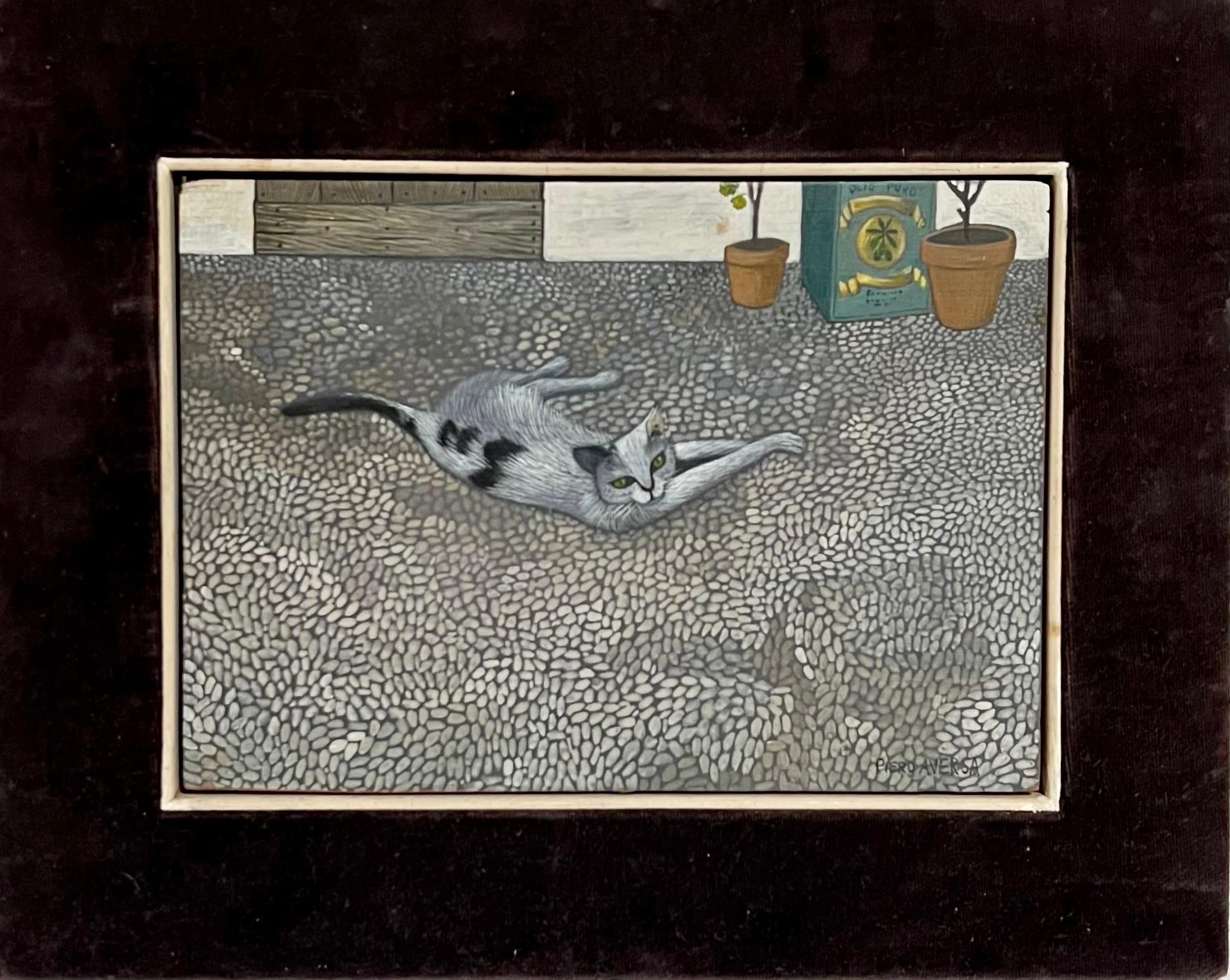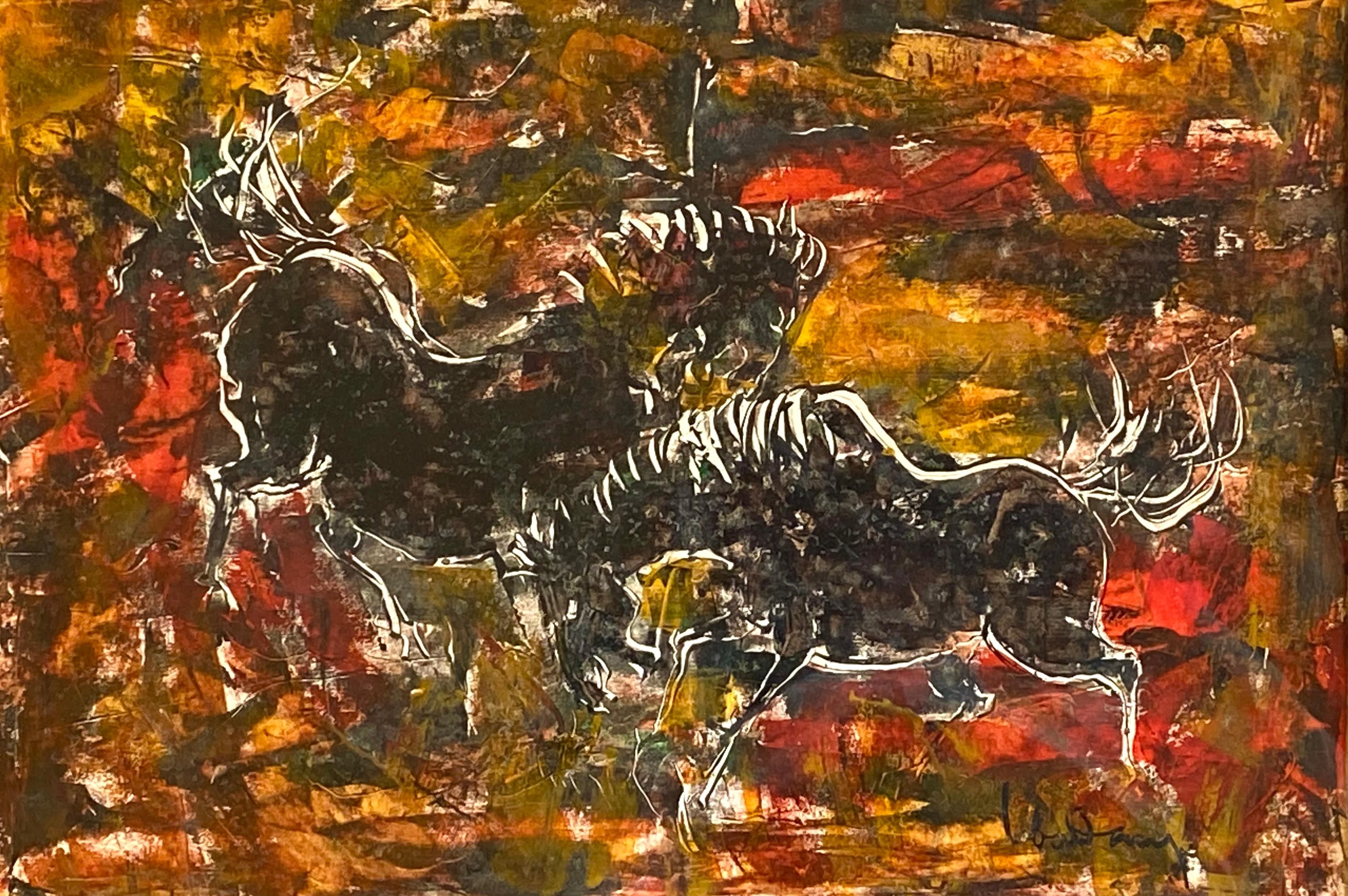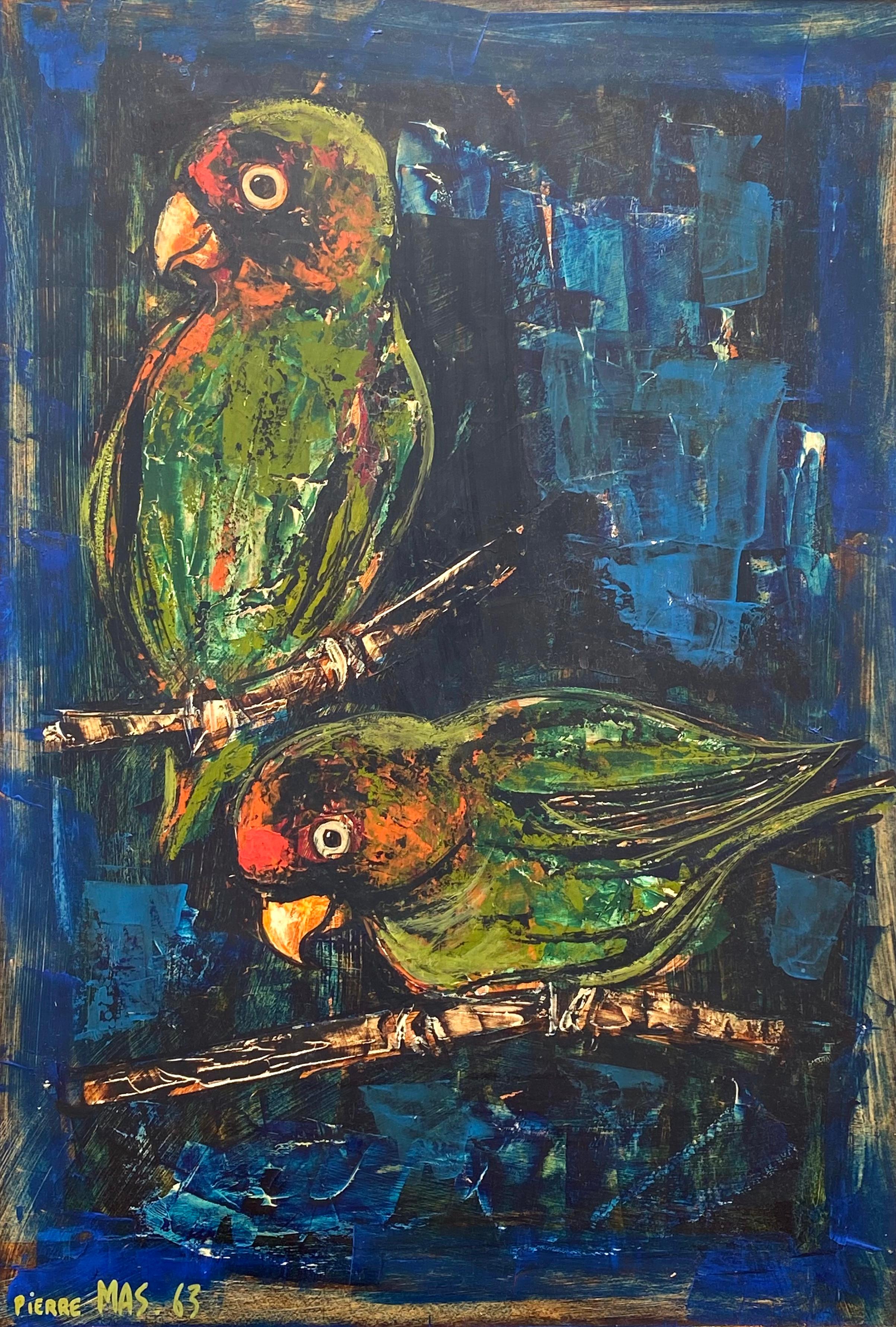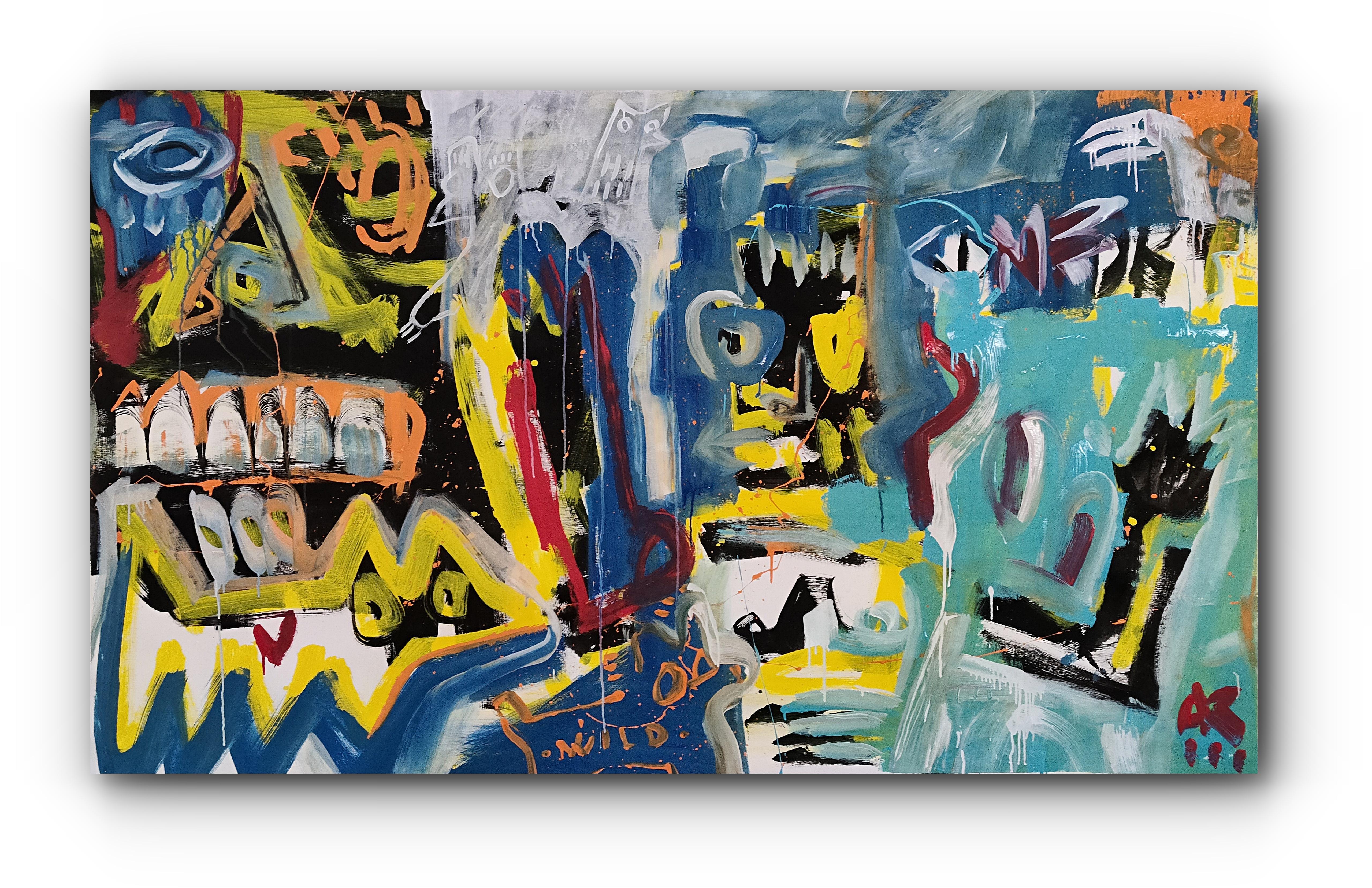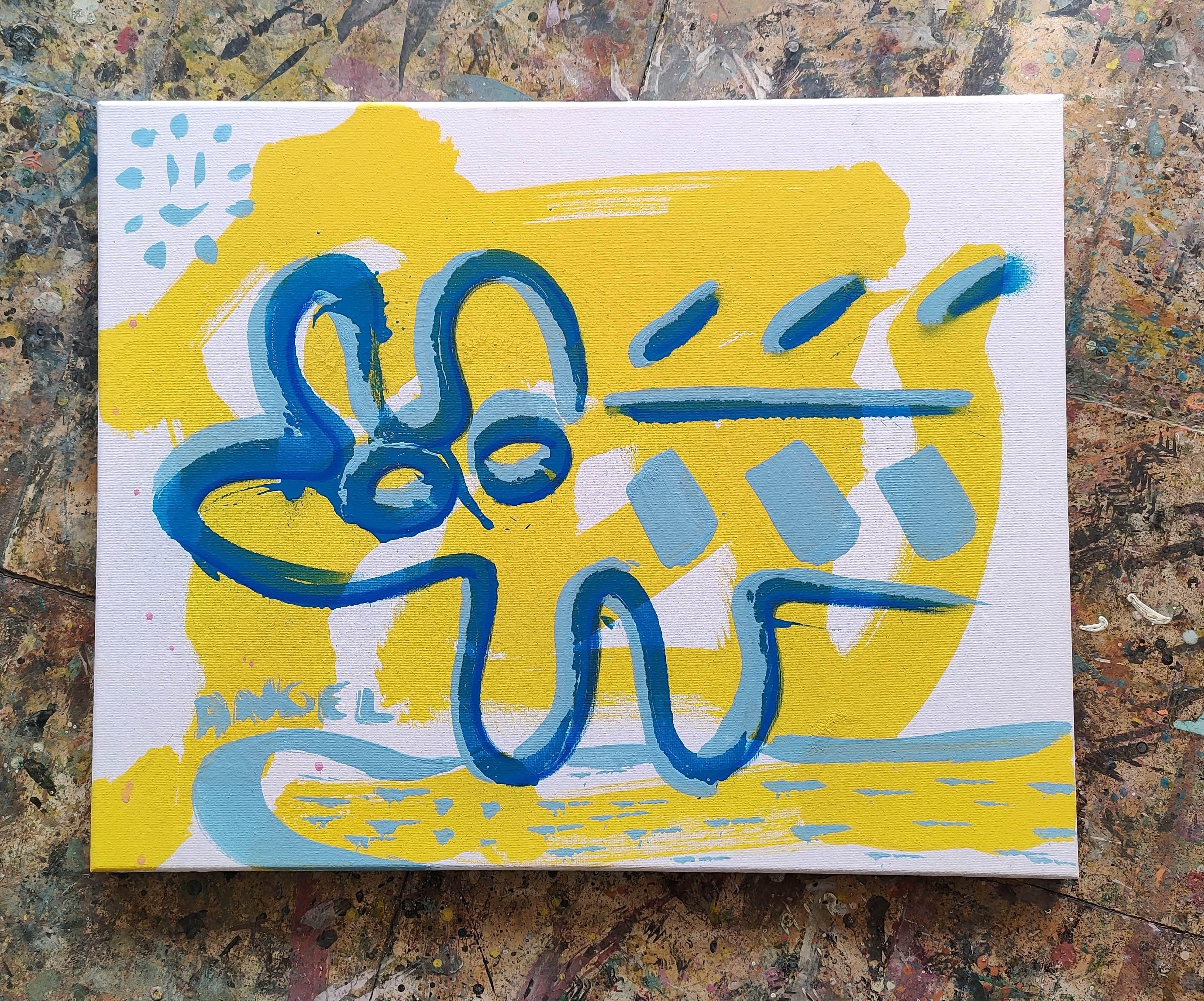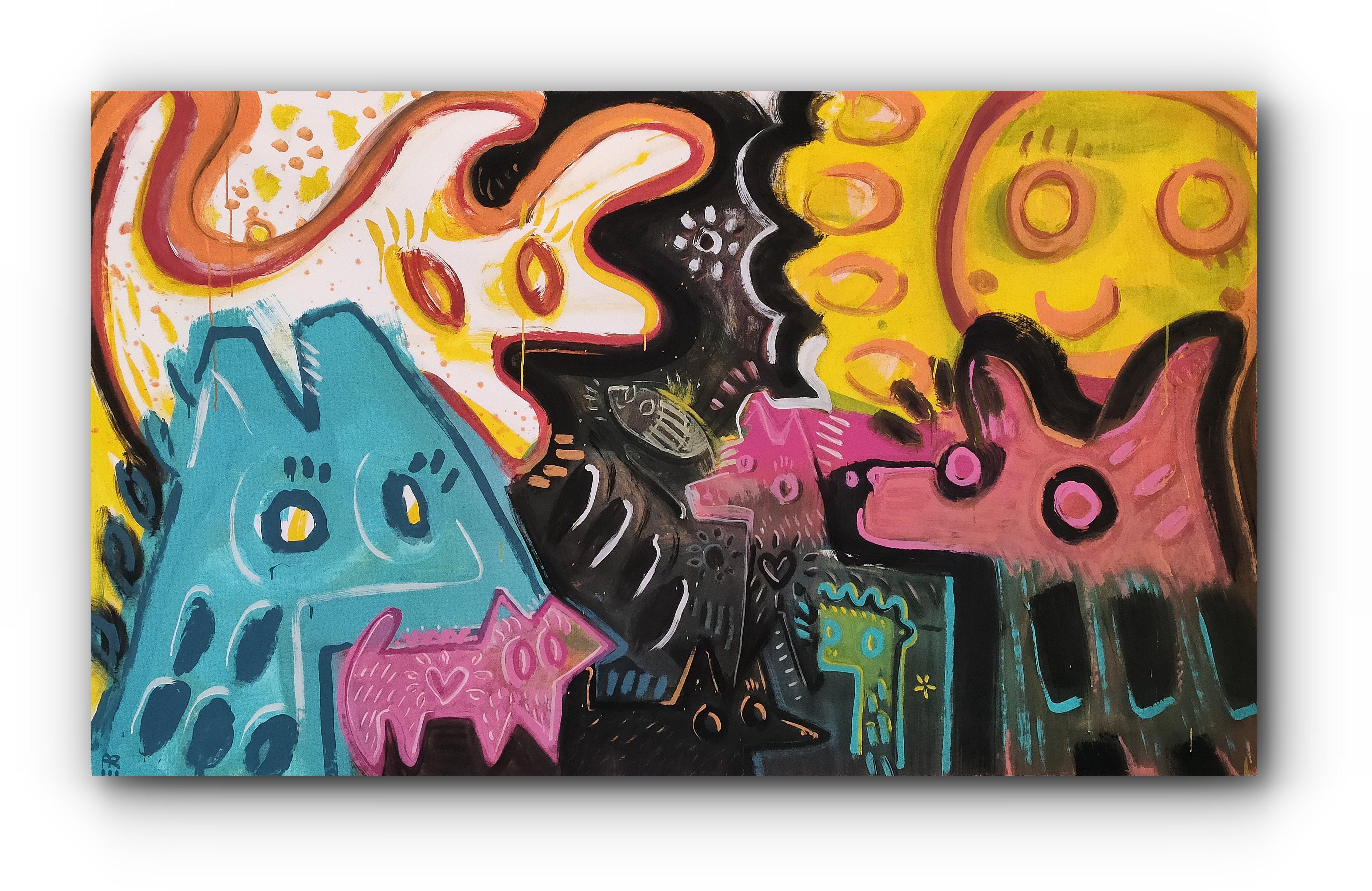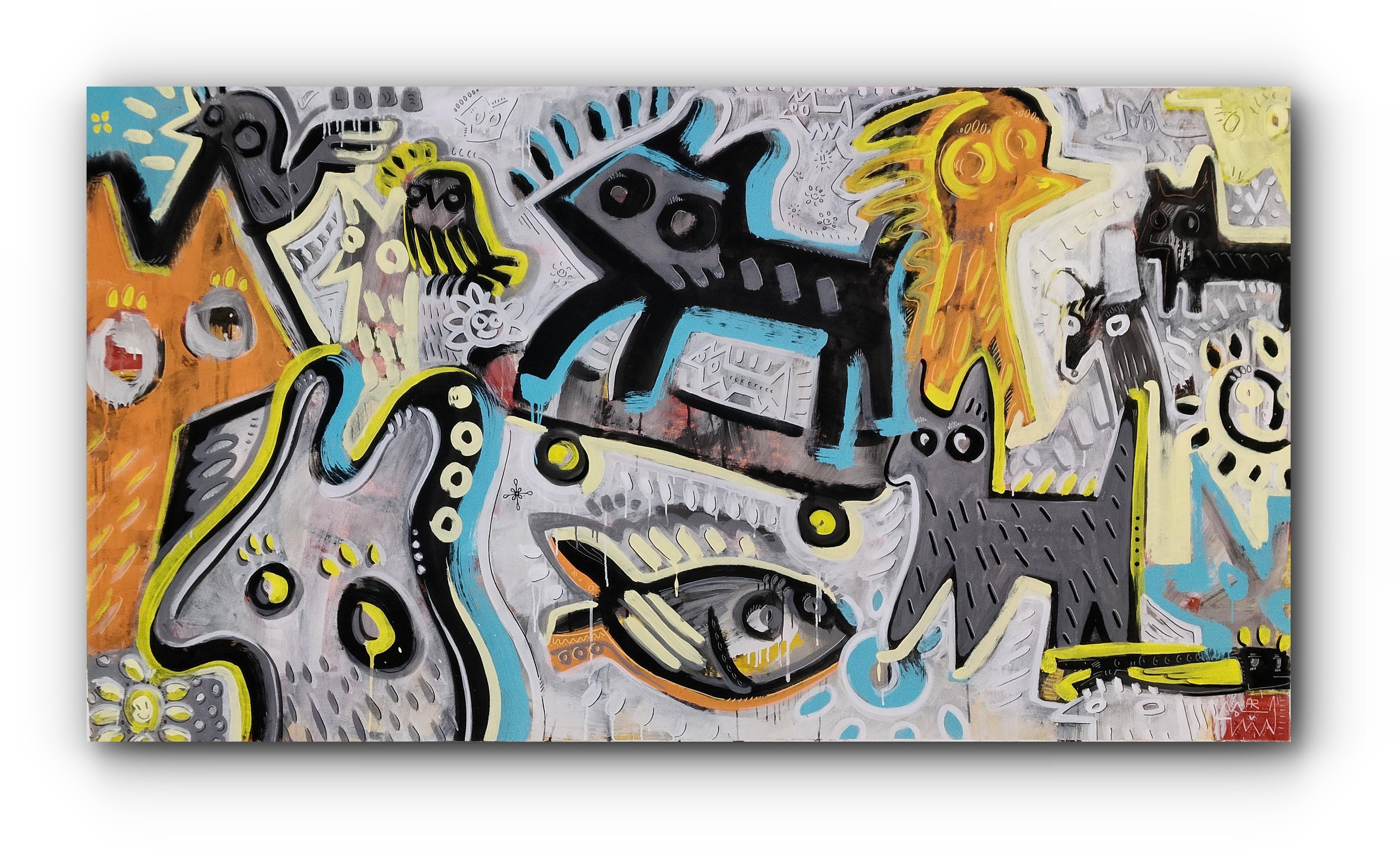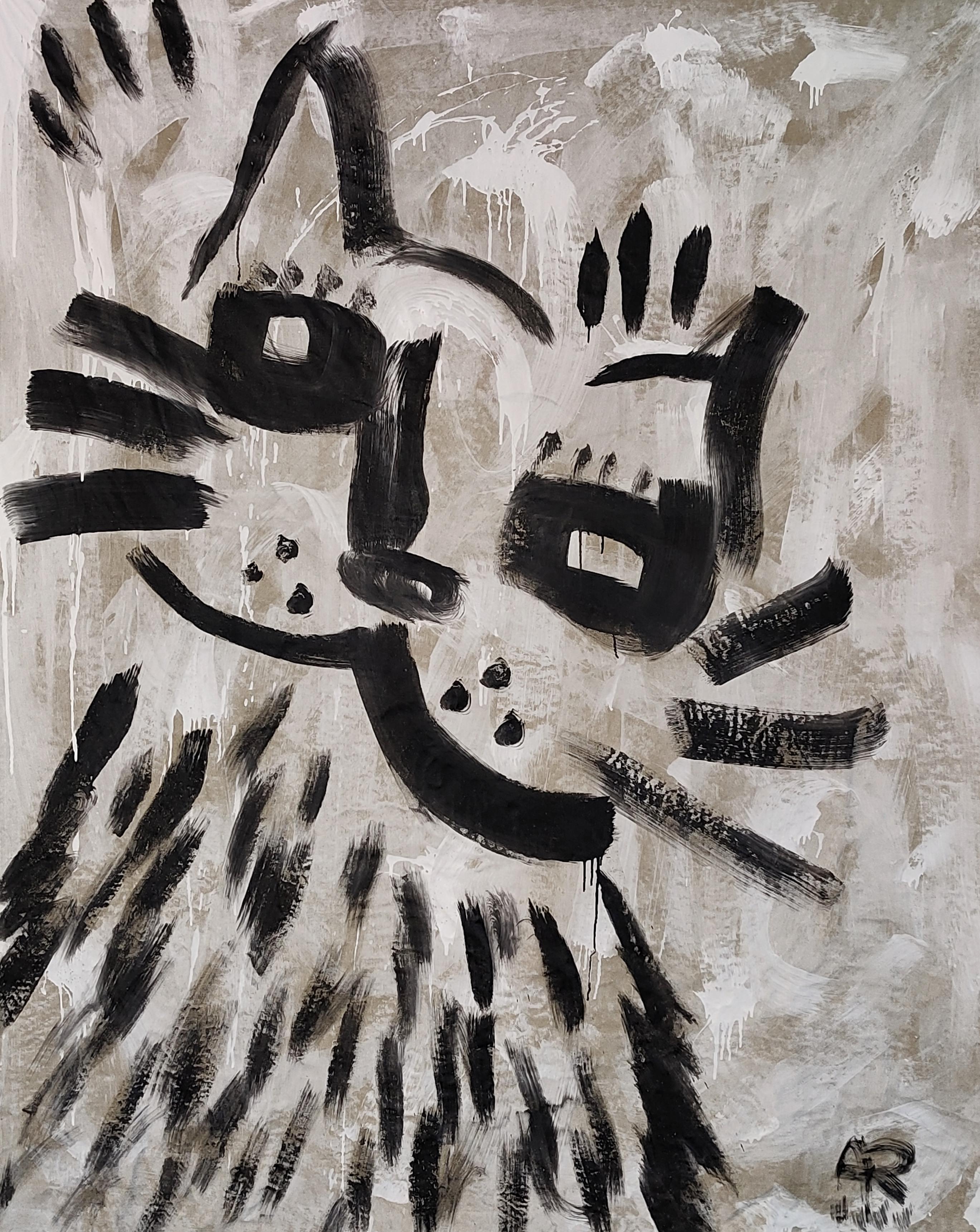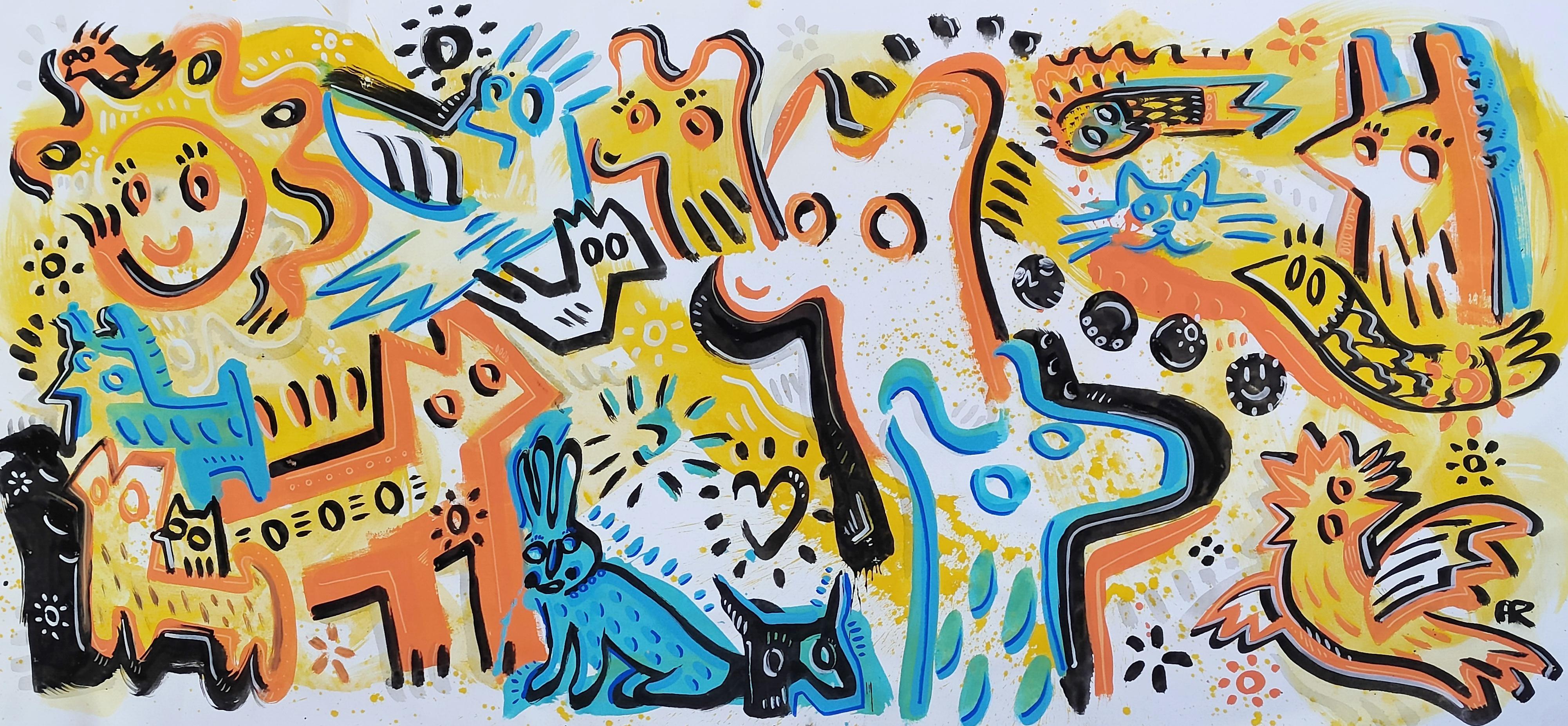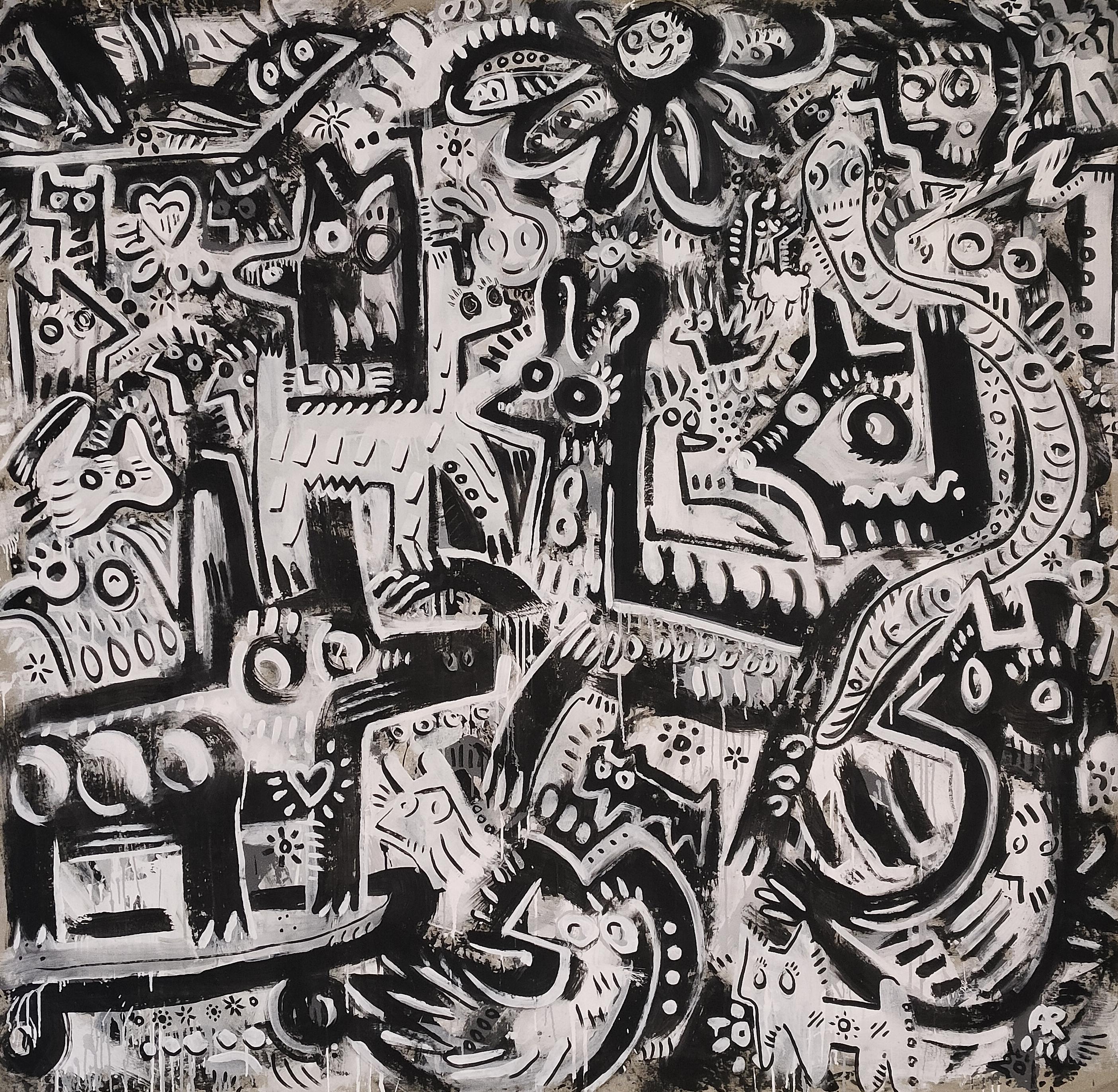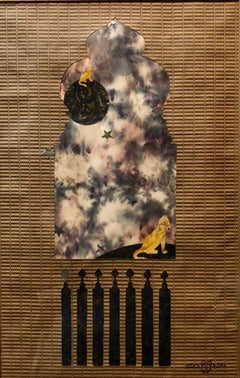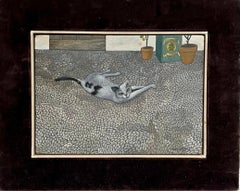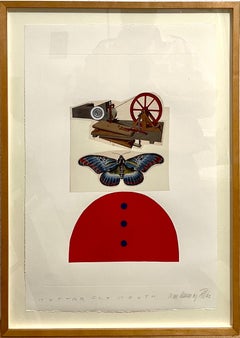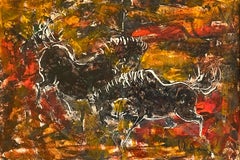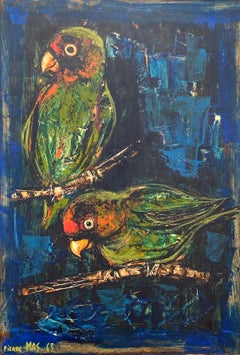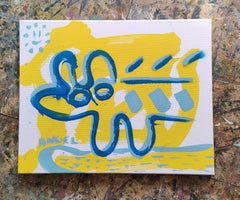
Original Paloma Picasso Vintage Paper and Foil Collage Painting Cat
View Similar Items
Want more images or videos?
Request additional images or videos from the seller
1 of 6
Paloma PicassoOriginal Paloma Picasso Vintage Paper and Foil Collage Painting Cat
About the Item
- Creator:Paloma Picasso (1949, French)
- Dimensions:Height: 23.75 in (60.33 cm)
- Medium:
- Movement & Style:
- Period:
- Condition:frame has minor wear.
- Gallery Location:Surfside, FL
- Reference Number:1stDibs: LU3822601841
About the Seller
4.9
Platinum Seller
These expertly vetted sellers are 1stDibs' most experienced sellers and are rated highest by our customers.
Established in 1995
1stDibs seller since 2014
1,549 sales on 1stDibs
Typical response time: 1 hour
More From This SellerView All
- Original Paloma Picasso Vintage Paper and Foil Collage Painting Cat Abstract ModBy Paloma PicassoLocated in Surfside, FLPaloma Picasso (born Anne Paloma Ruiz-Picasso y Gilot in Vallauris on 19 April 1949), is a French and Spanish fashion ans jewelery designer and businesswoman, best known for her jewelry designs for Tiffany & Co. and her signature perfumes. She is the youngest daughter of 20th-century artist Pablo Picasso and painter and writer Francoise Gilot. Paloma Picasso's older brother is Claude Picasso (b. 1947), her half-brother is Paulo Picasso (1921-1975), her half-sister is Maya (b. 1935), and she has another half-sister, Aurelia (b. 1956), from her mother's relationship with artist Luc Simon. After she graduated from school, her mother let her move alone to Venice, under the not terribly strict eye of her friend the eccentric collector Peggy Guggenheim. Paloma’s first husband was playwright Rafael Lopez-Cambil, with whom she lived a jet-set Warhol-era life (they once planned to make a film about Coco Chanel...Category
20th Century Post-Modern Animal Paintings
MaterialsPaper, Mixed Media
- Italian American Modernist Pattern Painting Key West Kitty Cat Piero Aversa ArtLocated in Surfside, FLMixed media on panel. Sprawling cat. Hand signed lower right. Dimensions: (Frame) H 8.25" x W 10.25" (Board) H 5" x W 7" Piero Aversa was born in Asmara, Eritrea, East Africa, educated at the Belle Arte in Rome, and lived and exhibited worldwide. He moved to the US in 1953. Piero Aversa was passionate about many facets of artistic expression. A larger than life Gay Artist, he enjoyed the company of many jet setters in New York City during his Fashion and Interior Design days. Originally from Italy he finally settled in Key West, Florida where the largest collection of his art is displayed. His talents span design in fabrics, wall covering, jewelry and films as well as the fine arts. The exhibition in Rome in 1959, of “The Most Beautiful Women of Rome”, catapulted him to international recognition. In New York, he designed celebrity mannequins for the windows of Saks Fifth Avenue. The depicted “New York's high-born, wealthy jet-setters” included Louise Savitt, Baby Jane Holzer and Wendy Vanderbilt. He is acknowledged for his sensitivity to the different lands he had been inspired by, from the primitive backdrops of Greek Mythology to the botanical lushness of Mexico, Italy, Greece and the Southern United States. He established his own line of wallpapers and fabrics, receiving praise for his interior design of suites at the historic Colony Hotel in Palm Beach, Florida. Aversa was collected by actresses Katherine Hepburn and Agnes Moorehead; diplomat and prominent New York socialite, Francis Kellogg; gallery owner, Julius Fleischmann; society songstress and millionaire industrialist, Mr. & Mrs. David Muss; and American songwriter, Jule Styne. He was also collected by various Italian nobility, Count and Countess Scribani Rossi from Rome, Principessa Niky Boncompagni, and Countess Alicia Paolozzi from Rome. The arrival of Piero in Mykonos, Greece and opening of his bar in the early 70's began a somewhat historical era for the gay community of the time. His work has a Surrealist quality that reminds me of Van Eno another Key West art...Category
1970s Post-Modern Animal Paintings
MaterialsMixed Media, Board
- Surrealist Photo Collage Assemblage Art Butterfly Mouth Ivan ChermayeffBy Ivan ChermayeffLocated in Surfside, FLIvan Chermayeff (1932-2017): Butterfly Mouth Mixed media collage, 2002, hand signed 'Ivan Chermayeff' and dated lower right, titled lower left. Bears label from David Findlay Jr. Gallery, NY. 22 1/2 x 15 in. (sheet), 25 3/4 x 18 1/4 in. (frame). Provenance: The estate of the artist. Ivan Chermayeff born London, United Kingdom, 1932 Chermayeff was one of the greatest American graphic designers, the son of the Russian born, British architect Serge Chermayeff. Ivan Chermayeff Graduated from the Phillips Academy of Andover, Massachusetts in 1950. He studied at Harvard until 1952, and the Institute of Design (New Bauhaus) until 1954. Graduated from the Yale School of Arts and Architecture in 1955 with a Bachelor of Fine Arts. The same year he did a short apprenticeship with Alvin Lustig—a pioneer of American graphic design—and then moved on to CBS as Assistant Art Director in record cover design. In 1956 he co-founded Brownjohn, Chermayeff & Geismar Associate, with Robert Brownjohn and his former schoolmate Tom Geismar. In 1959 Brownjohn left and the studio changed to Chermayeff & Geismar Inc. It soon became one of the best-known design firms worldwide. The firm produced over six-hundred marks, and they were among the very first to develop an abstract trademark (Chase Bank, 1960), still in use today. In 1964 they designed the outstanding corporate identity of Mobil Oil, that is one of the most recognizable identities ever. From its foundation, the studio served major companies including Giorgio Armani, Barneys, Hearst, MoMA (Museum of Modern Art), National Geographic, NBC (National Broadcasting Company), PBS (Public Broadcasting Service), Rockefeller, and others. Recently, Serge Haviv joined as a new partner and the firm changed to Chermayeff & Geismar & Haviv. Besides his design profession, Chermayeff is a talented illustrator artist and collagist. Many graphic pieces he made show a perfect balance of rational logics with imagination, featuring both abstract geometric shapes and figurative images. His collage works require a same sense of witty assemblage, where gathered information, like scraps of paper, stamps, and Polaroid photograph pictures combine as fragmented clues to a greater message. The Surrealist collages often take the shape of people, whose facial features are born of scraps and daily ephemera. They are amusing and infinitely thought-provoking; as Chermayeff has said, “Collages make it possible for everything to be something else.” Board overseers at Parsons School of Design and trustee at New School University from 1988 to 2002. Visiting professor at Cooper Union, University of California, and Kansas City Art Institute. He started making collages at the age of 17 to overcome his fear of not being able to draw. They are mostly made from day-to-day ephemera: envelopes, stamps, cigarette packs, train tickets, strips of coloured paper, found images, stones from the beach or squashed rusty cans. Inspired by Surrealism and organised by the artist’s hand and complemented with strong lines, they make faces, figures, fragmented narratives. Like all great designs, they evoke surprise and the pleasure of recognition. As he put it: “Design is all about seeing and making connections which are not so obvious.”President of AIGA (American Institute of Graphic Arts) from 1963 to 1966. Trustee of MoMA (Museum of Modern Art) from 1965 to 1986. Member of the board of directors of IDCA (International Design Conference in Aspen) from 1968 to 1999. Board Director at Municipal Art Society of New York in 1972-76. Member of AGI (Alliance Graphique Internationale) since 1978. Board Director at Smithsonian Institution from 1988 to 1996. He was elected to the Hall of Fame of ADC New York (Art Directors Club) in 1982. Trustee of the Archives of America Art in 1987-90. Royal Designer for Industry since 1992. He was awarded numerous prizes including the Industrial Art Medal from AIA (American Institute of Architects) in 1967, the Philadelphia College of Art Gold Medal in 1971, AIGA Gold Medal (American Institute of Graphic Arts) in 1979, the President’s Fellow Award from the Rhode Island School of Design in 1981, the First International Design Award from Japan Design Foundation in 1983, the Yale Arts Medal in 1985, the Distinguished Service Award from New School University in 1999, the Society of Illustrators Gold Medal in 2002, the Tokyo Type Directors Club Award in 2004, and the National Design Award for Lifetime Achievement in 2014. He also received a honorary doctorate in law from the Portland School of Art in 1981, and two honorary doctorates in fine arts from the Philadelphia University of Arts and the Corcoran Museum of Art, Washington in 1991. Along with Seymour Chwast, Sid Chafetz, Saul Bass, Milton Glaser, Paul Rand, Ikko Tanaka...Category
Early 2000s Surrealist Mixed Media
MaterialsPaper, Mixed Media
- Collage, Assemblage Cardstock Painting David Gilhooly California Funk SurrealismBy David GilhoolyLocated in Surfside, FLDAVID JAMES GILHOOLY (American, 1943-2013), Mixed media collage 6 x 4 inches, Hand signed and dated verso titled: "Many frivolous titles come to mind" A man on horseback, man and horse. cut and pasted cardstock assemblage, collaged art. David Gilhooly RCA (1943 – 2013), was an American ceramicist, sculptor, painter, printmaker, and professor. He is best known for pioneering the Funk art movement. He made a series of ceramic frogs called FrogWorld, as well as ceramic food, planets, and other creatures. David James Gilhooly III was born on April 15, 1943, in Auburn, California. He was raised in Los Altos, California; Saint Croix in the Virgin Islands; and Humacao, Puerto Rico. He enrolled in University of California, Davis (UC Davis) initially studying biology, followed by anthropology, and ending with a focus on fine art. While attending UC Davis, Gilhooly served as artist Robert Arneson assistant starting in 1963. He graduated from UC Davis with a BA degree in 1965, and an MA degree in 1967. Gilhooly, together with Robert Arneson, Peter Vandenberge...Category
2010s Surrealist Mixed Media
MaterialsPaper, Ink, Watercolor
- American Neo Expressionist "Wild Horses" Modernist Oil PaintingBy Robert BeauchampLocated in Surfside, FLRobert Beauchamp (1923 – March 1995) was an American figurative painter and arts educator. Beauchamp's paintings and drawings are known for depicting dramatic creatures and figures with expressionistic colors. His work was described in the New York Times as being "both frightening and amusing,". He was a Guggenheim Fellow and a student of Hans Hofmann. Robert Beauchamp was born in Denver, Colorado in 1923. He had three brothers and three sisters, and the children were orphaned by both parents by the time Beauchamp was three. The family grew up impoverished due to the Great Depression, living in a community house with other families. As a child he dabbled in art but it wasn't until high school that he began taking art classes. When not creating art he also played sports; football and basketball, and enjoyed chemistry and geology. He was told he was good at drawing, and replaced study hall classes with art classes, receiving instruction and inspiration from a Welsh teacher named R. Idris Thomas. While in high school Beauchamp would go, every Monday, to the public library and a local museum where he would read books about art; specifically French painting, as assigned by Thomas. Beauchamp absorbed the tenets of European Modernism and American Abstract Expressionism—with which he eventually broke. While abstraction, with its focus on color and form, underlies his compositions, he filled canvas and paper with psychologically acute portraits of himself and others, nudes, animals, and objects of all kinds. Beauchamp would spend upwards of four hours a day in the art room and eventually won the Carter Memorial Prize, which provided a scholarship to the Colorado Springs Fine Arts Center. At Colorado Springs he studied under Boardman Robinson, painting landscapes in nature. Beauchamp eventually joined the Navy and then returned to Colorado Springs to continue his studies. Traveling the world as an Armed Guard, he spent a year and a half at sea and the rest of the three years in San Francisco. Seeking to make money, and to follow his love for a girl, Beauchamp decided to attend Cranbrook Academy of Art from 1947–1948. There he studied pottery, believing one could "make more money selling pots than you could selling paintings." He described his experience at Cranbrook as intimidating and claustrophobic, and eventually switched to sculpture before switching to painting. Beauchamp moved to New York City in the early 1950s and was involved in the Tenth Street galleries, which provided outlets for more experimental artists and the second generation of abstract expressionists. Despite his involvement with 10th Street and friendships with abstract artists, abstract art never interested in him. He showed at numerous galleries in New York and Provincetown, socializing with gallery owners, artists and collectors. His first exhibition was at the Tanager Gallery in New York, he also showed during the 1950s at the Hansa Gallery. In New York and Provincetown he studied under Hans Hofmann Eventually he felt that abstract expressionism became dull and stalemated. During the 1960s he showed at the Green Gallery. C. 1960 he was awarded a Fulbright Award allowing him to travel to La Romola, Italy. He traveled frequently to cities such as Rome and worked constantly. Beauchamp returned to the states and lived in Provincetown at Walter Gutman's house, who awarded Beauchamp a grant. That year he met his future wife, Nadine Valenti, whom he married in 1967. Beauchamp taught at a variety of schools during his lifetime including Brooklyn College, School of Visual Arts, Cooper Union and the Art Students League of New York during the last fifteen years of his life. Beauchamp described his drawings as painterly, seeking the spontaneity in an image. He would develop a drawing then a painting, and vice versa. His heavily impastoed paintings, often described as sculptures themselves, came from the pouring of paint from a can, with little planning and constant evolution in the medium upon the canvas. He preferred little planning to his creations, believing that an artists work would become stale and repetitive with constant planning. He also created large scale works, at times 70 inches long. Beauchamp had little intention of ever selling his large works, preferring to create them due to the slow and intense experience he received from the process. The large drawings he created on the floor, and the smaller works were created on a table. Paintings were created on either the floor or wall and he described his painting process as "splattering", "pushing the paint around," and sponging. Animals often appear in his paintings, despite a dislike for domestic animals outside of his artistic creations. He called the characters in his paintings as Beauchamps. Some Beauchamps hold meaning, with Beauchamp rarely sharing the meaning behind the symbols and characters. He made up the creatures himself, seeking to emphasize the character of each. In 2006 the University of Massachusetts Amherst College of Visual & Performing Arts hosted an exhibition of Beauchamp's pieces from the 1960s, curators stated that Beauchamp's work: "effortlessly blends innovative style elements with narrative, descriptive images. One senses equal enjoyment in the manipulation of, and interaction with, color and paint, and the often sudden and unexpected presence of a wasp or a lump of sugar." included in the important exhibit "Twelve New York Painters." New York: David Findlay Jr. Fine Art with Mary Abbott, Alcopley, Robert Beauchamp, Byron Browne, Charles Cajori, Jim Forsberg, Carl Heidenreich, Angelo Ippolito, Emily Mason, Robert Natkin, Robert Richenburg and Nina Tryggvadottir...Category
20th Century Neo-Expressionist Abstract Paintings
MaterialsPaper, Oil
- American Neo Expressionist "Wild Horses" Modernist Oil PaintingBy Robert BeauchampLocated in Surfside, FLSigned lower left. Robert Beauchamp (1923 – March 1995) was an American figurative painter and arts educator. Beauchamp's paintings and drawings are known for depicting dramatic creatures and figures with expressionistic colors. His work was described in the New York Times as being "both frightening and amusing,". He was a Guggenheim Fellow and a student of Hans Hofmann. Robert Beauchamp was born in Denver, Colorado in 1923. He had three brothers and three sisters, and the children were orphaned by both parents by the time Beauchamp was three. The family grew up impoverished due to the Great Depression, living in a community house with other families. As a child he dabbled in art but it wasn't until high school that he began taking art classes. When not creating art he also played sports; football and basketball, and enjoyed chemistry and geology. He was told he was good at drawing, and replaced study hall classes with art classes, receiving instruction and inspiration from a Welsh teacher named R. Idris Thomas. While in high school Beauchamp would go, every Monday, to the public library and a local museum where he would read books about art; specifically French painting, as assigned by Thomas. Beauchamp absorbed the tenets of European Modernism and American Abstract Expressionism—with which he eventually broke. While abstraction, with its focus on color and form, underlies his compositions, he filled canvas and paper with psychologically acute portraits of himself and others, nudes, animals, and objects of all kinds. Beauchamp would spend upwards of four hours a day in the art room and eventually won the Carter Memorial Prize, which provided a scholarship to the Colorado Springs Fine Arts Center. At Colorado Springs he studied under Boardman Robinson, painting landscapes in nature. Beauchamp eventually joined the Navy and then returned to Colorado Springs to continue his studies. Traveling the world as an Armed Guard, he spent a year and a half at sea and the rest of the three years in San Francisco. Seeking to make money, and to follow his love for a girl, Beauchamp decided to attend Cranbrook Academy of Art from 1947–1948. There he studied pottery, believing one could "make more money selling pots than you could selling paintings." He described his experience at Cranbrook as intimidating and claustrophobic, and eventually switched to sculpture before switching to painting. Beauchamp moved to New York City in the early 1950s and was involved in the Tenth Street galleries, which provided outlets for more experimental artists and the second generation of abstract expressionists. Despite his involvement with 10th Street and friendships with abstract artists, abstract art never interested in him. He showed at numerous galleries in New York and Provincetown, socializing with gallery owners, artists and collectors. His first exhibition was at the Tanager Gallery in New York, he also showed during the 1950s at the Hansa Gallery. In New York and Provincetown he studied under Hans Hofmann Eventually he felt that abstract expressionism became dull and stalemated. During the 1960s he showed at the Green Gallery. C. 1960 he was awarded a Fulbright Award allowing him to travel to La Romola, Italy. He traveled frequently to cities such as Rome and worked constantly. Beauchamp returned to the states and lived in Provincetown at Walter Gutman's house, who awarded Beauchamp a grant. That year he met his future wife, Nadine Valenti, whom he married in 1967. Beauchamp taught at a variety of schools during his lifetime including Brooklyn College, School of Visual Arts, Cooper Union and the Art Students League of New York during the last fifteen years of his life. Beauchamp described his drawings as painterly, seeking the spontaneity in an image. He would develop a drawing then a painting, and vice versa. His heavily impastoed paintings, often described as sculptures themselves, came from the pouring of paint from a can, with little planning and constant evolution in the medium upon the canvas. He preferred little planning to his creations, believing that an artists work would become stale and repetitive with constant planning. He also created large scale works, at times 70 inches long. Beauchamp had little intention of ever selling his large works, preferring to create them due to the slow and intense experience he received from the process. The large drawings he created on the floor, and the smaller works were created on a table. Paintings were created on either the floor or wall and he described his painting process as "splattering", "pushing the paint around," and sponging. Animals often appear in his paintings, despite a dislike for domestic animals outside of his artistic creations. He called the characters in his paintings as Beauchamps. Some Beauchamps hold meaning, with Beauchamp rarely sharing the meaning behind the symbols and characters. He made up the creatures himself, seeking to emphasize the character of each. In 2006 the University of Massachusetts Amherst College of Visual & Performing Arts hosted an exhibition of Beauchamp's pieces from the 1960s, curators stated that Beauchamp's work: "effortlessly blends innovative style elements with narrative, descriptive images. One senses equal enjoyment in the manipulation of, and interaction with, color and paint, and the often sudden and unexpected presence of a wasp or a lump of sugar." included in the important exhibit "Twelve New York Painters." New York: David Findlay Jr. Fine Art with Mary Abbott, Alcopley, Robert Beauchamp, Byron Browne, Charles Cajori, Jim Forsberg, Carl Heidenreich, Angelo Ippolito, Emily Mason, Robert Natkin, Robert Richenburg and Nina Tryggvadottir...Category
20th Century Neo-Expressionist Abstract Paintings
MaterialsPaper, Oil
You May Also Like
- “Wild Horses”By Hoi LebadangLocated in Southampton, NYOriginal oil painting on archival paper by the renowned Vietnamese and French artist, Hoi Lebadang of two wild horses. Signed lower right by the artist. Condition is excellent. Cir...Category
1960s Post-Modern Animal Paintings
MaterialsOil, Archival Paper
- “Parrots”Located in Southampton, NYOriginal oil on heavy card stock painting of a pair of parrots in a post modern style by the French artist, Pierre Mas. Signed lower left and dated 1963. C...Category
1960s Post-Modern Animal Paintings
MaterialsOil, Board
$1,200 Sale Price25% Off - STREET DOGBy Angel RivasLocated in CÓRDOBA, ESAcrylic on canvas Ready to hangCategory
2010s Post-Modern Animal Paintings
MaterialsPermanent Marker, Spray Paint, Acrylic
- FLUID NATUREBy Angel RivasLocated in CÓRDOBA, ESAcrylic on canvas Shipped rolled in a tubeCategory
2010s Post-Modern Animal Paintings
MaterialsPermanent Marker, Acrylic
- HAPPY NATUREBy Angel RivasLocated in CÓRDOBA, ESAcrylic on canvas Shipped rolled in a tubeCategory
2010s Post-Modern Animal Paintings
MaterialsPermanent Marker, Acrylic
- HANDS UPBy Angel RivasLocated in CÓRDOBA, ESAcrylic on canvas Shipped rolled in a tubeCategory
2010s Post-Modern Animal Paintings
MaterialsGold Leaf
Recently Viewed
View AllMore Ways To Browse
Collage Painting
Vintage Paper Art
Picasso Art Work
Vintage Paper
Original Picasso
Picasso Originales
Original Art Picasso
Picasso Paper
Picasso Paris
Picasso On Paper
Original Collage Art
Picasso Museum
Picasso The Painter
Paintings By Pablo Picasso
Original Picasso Paintings
Chicago Original Painting
Original Painting By Picasso
Vintage Collage Paper
